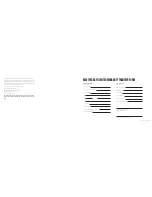
2017 OWNERS MANUAL /
436
Towing Requirements
States and municipalities may require special permits and licenses
based on the size and weight of your trailer. Some states require
additional equipment for the tow vehicle, such as side and rear view
mirrors. Inquire at your local motor vehicle administration office to
find out what requirements affect you.
If you plan to travel in another state, don’t forget to check require-
ments there also. In addition to licenses and permits, there may be
weight, height and width limits for using certain roads, bridges and
tunnels. Also, be aware of restrictions regarding the transport of
gases or fuels in tunnels.
And don’t forget to contact your insurance company to make sure
you have proper coverage for all types of towing situations. Some
jurisdictions may also require liability insurance. If you have a loan
for the trailer purchase, your lender may also require insurance.
Trailer Checklist
Before towing the vehicle, be sure to read and familiarize yourself
with the instructions and warnings supplied with it.
Never Tow This Vehicle Before Safety Checking
• Coupler, hitch and hitch ball are of the same size
• Breakaway cable is properly attached to the tow vehicle
• Coupler and safety chains are safely secured to the hitch of the
tow vehicle
it increases the possibility of causing damage to the boat and/or
the trailer. Such damage is not covered as noted in section 3 of the
limited warranty statement.
The hull geometry and strake design and configuration of the X10
is more sensitive to trailer loading depth. The strakes are closer
together, flatter and come forward farther than most early model
MasterCraft boats. In addition to these features, the traditional
V-shaped bow makes it easier to approach the trailer off centerline.
(The pickle-fork geometry on other boat model hulls helps align
the front of the boat in the center of the trailer while approaching.)
Use extra care when loading and unloading X10 models from their
trailers.
Through testing, it has been determined that the trailer should be
backed to a minimum depth as measured on the guide pole (from
the step height up to the guide pole measurement). It is suggested
that some sort of visual indicator be placed on the guide poles as
suggested in the note above.
Boat Model Wheel/Tire Profile
Ramp Type
Flat
Normal Steep
X10
Standard
18”
22”
25”
Low
16”
20”
23”
Standard
18”
18”
18”
Low
16”
16”
16”
• All fasteners are properly tightened
• Boat is securely tied down to trailer (winch line is not a tie down)
• Wheel lug nuts are properly tightened
• Wheel bearings are properly adjusted and maintained
• Load is within the maximum load carrying capacity
• Load inside the boat is properly distributed
• Tires are properly inflated
• All trailer lighting is working properly
• Trailer brakes are properly adjusted and working (if trailer is so
equipped).
• Tower on the boat (if so equipped) is secure, whether it is upright
and locked in place or has been lowered
• Sufficient overhead clearance before removing the boat/trailer
from cover, or when towing so that the unit will clear any overhead
items such as trees, bridges, overhead power lines, overpasses,
etc.
This trailer is manufactured to meet the applicable federal safety
standards at the time of manufacture. Check the local and state
requirements regarding any additional equipment that may be
required.
NOTE: Trailer laws covering such things as brakes, lights, safety
cables, licenses, etc., will vary from state to state. Be sure that the
trailer is in full compliance with applicable state laws. An authorized
MasterCraft dealer can help in this regard. Otherwise, contact the
nearest state motor vehicle department.
Please bear in mind that these are recommended depths as mea-
sured under conditions at the factory-based lake. Adjustments
may be necessary, depending on load distribution in the boat as
well as the angle of the ramp where the boat is being used.
Power loading is always possible, but winching on the last few inch-
es may be necessary, depending on the steepness of the ramp. As
with most boats including the X10 and XT23, if the trailer is backed
in too far on a particularly steep ramp, the bow can easily go under
the bow roller. Approaching the trailer very slowly (typically in neu-
tral) is recommended.
Unloading depth can (and should be) somewhat deeper than these
recommended loading depths, as the bunks are not needed to
guide the boat off the trailer. Power unloading can burn the carpet in
the same manner as power loading.
Following loading, wet brakes may not hold and/or may cause
brakes to have diminished performance characteristics. A few
braking applications at a slow speed will help to dry them out. Ex-
tra care must be used when braking after brakes have become wet.
Summary of Contents for NXT20 2017
Page 3: ...2017 OWNERS MANUAL SAFETY KNOWLEDGE ...
Page 27: ...2017 OWNERS MANUAL 48 2017MODEL FEATURESANDSPECS ...
Page 40: ...2017 OWNERS MANUAL 74 DASHESAND VIDEOSCREENS ...
Page 42: ...2017 OWNERS MANUAL 78 XANDXTSERIESINSTRUMENTPANEL 4 3 VIDEOSCREEN XSTARINSTRUMENTPANEL ...
Page 43: ...2017 OWNERS MANUAL 80 PROSTARINSTRUMENTPANEL NXTSERIESINSTRUMENTPANEL ...
Page 58: ...2017 OWNERS MANUAL 110 XANDXTSERIES VIDEOSCREEN OPERATIONSHV450 ...
Page 67: ...2017 OWNERS MANUAL 128 XSTAR VIDEOSCREEN OPERATIONS XSTARINSTRUMENTPANEL ...
Page 80: ...2017 OWNERS MANUAL 154 PROSTAR VIDEOSCREEN OPERATIONS ...
Page 97: ...2017 OWNERS MANUAL 188 NXT OPERATIONS ...
Page 101: ...2017 OWNERS MANUAL 196 NXT20 22 VIDEOSCREEN OPERATIONS ...
Page 107: ...2017 OWNERS MANUAL 208 BOAT OPERATIONS ...
Page 158: ...2017 OWNERS MANUAL 310 PREPARATION ...
Page 172: ...2017 OWNERS MANUAL 338 CAREAND MAINTENANCE ...
Page 204: ...2017 OWNERS MANUAL 402 TRAILERS ...
















































